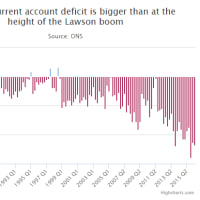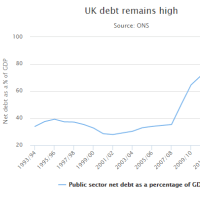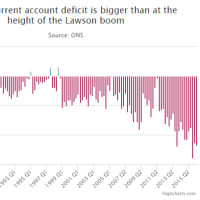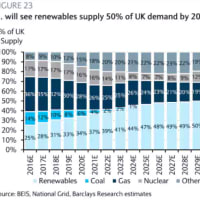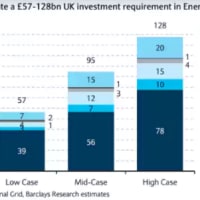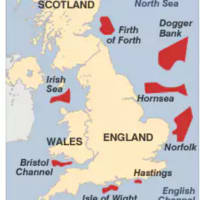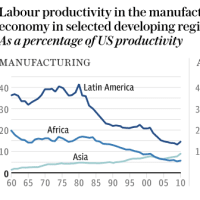Crisis may make 1929 look a 'walk in the park'
(危機は1929年を「なんでもなく」見せるかもしれない)
Ambrose Evans-Pritchard
Telegraph:23/12/2007
(危機は1929年を「なんでもなく」見せるかもしれない)
Ambrose Evans-Pritchard
Telegraph:23/12/2007
As central banks continue to splash their cash over the system, so far to little effect, Ambrose Evans-Pritchard argues things are rapidly spiralling out of their controlつづく
中央銀行、現ナマばら撒き続けれど、効果はほとんど見当たらず…状況は急速に制御不能になりつつある
Twenty billion dollars here, $20bn there, and a lush half-trillion from the European Central Bank at give-away rates for Christmas. Buckets of liquidity are being splashed over the North Atlantic banking system, so far with meagre or fleeting effects.
クリスマス向に、こっちに$200億、あっちに$200億、でもってECBからは超バーゲン金利で€1/2兆の大盤振る舞いがあった。
北大西洋銀行制度には、これでもかこれでもか、と流動性がぶちまけられたが、取り敢えずこれまでのところ、効果はちっぽけか儚いものである。
As the credit paralysis stretches through its fifth month, a chorus of economists has begun to warn that the world's central banks are fighting the wrong war, and perhaps risk a policy error of epochal proportions.
信用麻痺が5ヶ月目に突入する中、世界の中央銀行の矛先は見当違いで、歴史的規模の政策ミスを犯しているかもしれない、とのエコノミストの大合唱が始まった。
"Liquidity doesn't do anything in this situation," says Anna Schwartz, the doyenne of US monetarism and life-time student (with Milton Friedman) of the Great Depression.
「この状況で流動性なんて何の役にも立たないわよ」
と米マネタリズムの女帝であり(ミルトン・フリードマンと一緒)に永遠の大恐慌の探求者である、アナ・シュワルツは言う。
"It cannot deal with the underlying fear that lots of firms are going bankrupt. The banks and the hedge funds have not fully acknowledged who is in trouble. That is the critical issue," she adds.
「こんなもん、会社が山ほど潰れるんじゃないか、なんて根底的な恐怖に対応出来ないわよ。銀行もヘッジファンドも、誰が困ってるか完全に認めていないじゃない。それが大問題なのよ」。
Lenders are hoarding the cash, shunning peers as if all were sub-prime lepers. Spreads on three-month Euribor and Libor - the interbank rates used to price contracts and Club Med mortgages - are stuck at 80 basis points even after the latest blitz. The monetary screw has tightened by default.
貸し手は現ナマを積み上げ、まるで皆が皆、避けるべきサブプライムの村八分者の如く、同業者を避けている。
3ヶ月物EURIBORとLIBORのスプレッドは、先日の一斉攻撃後ですら80ベーシス・ポイントに張り付いている。
マネタリーの栓は最初から締められている。
York professor Peter Spencer, chief economist for the ITEM Club, says the global authorities have just weeks to get this right, or trigger disaster.
ITEMクラブのチーフ・ヨーロピアン・エコノミスト、ヨーク大学のピーター・スペンサー教授は、世界の当局がこれを直すか大惨事を引き起こすまで後数週間かなあ、とのたまわる。
"The central banks are rapidly losing control. By not cutting interest rates nearly far enough or fast enough, they are allowing the money markets to dictate policy. We are long past worrying about moral hazard," he says.
「中央銀行は急速に制御を喪失しているね。みみっちくどんくさく金利引き下げをやることで、連中は金融市場に主導権を渡してるんだね。モラル・ハザードなんぞ心配してる場合じゃないんだね」。
"They still have another couple of months before this starts imploding. Things are very unstable and can move incredibly fast. I don't think the central banks are going to make a major policy error, but if they do, this could make 1929 look like a walk in the park," he adds.
「これが崩壊し始めるまでの猶予は2ヶ月ほどね。物凄く不安定だし、恐ろしく素早く動くかもしれないのね。中央銀行が大きな政策ミスをするとは思わないけど、やっちゃったら、1929年の大恐慌も『子どもの遊び』みたいに見える事態になるかもね」。
The Bank of England knows the risk. Markets director Paul Tucker says the crisis has moved beyond the collapse of mortgage securities, and is now eating into the bedrock of banking capital. "We must try to avoid the vicious circle in which tighter liquidity conditions, lower asset values, impaired capital resources, reduced credit supply, and slower aggregate demand feed back on each other," he says.
BoEはそのリスクを知っている。
マーケット・ディレクターのポール・タッカーは、この危機はモーゲージ担保証券の破綻などというものではなく、今では銀行の資本基盤に食い込みつつある、と言う。
「融資条件が厳しくなり、資産価値が下がり、資本リソースが弱まり、信用供給が減り、そしてフィードバックし合う総需要が低迷する悪循環は、どうしても避けなければならない」。
New York's Federal Reserve chief Tim Geithner echoed the words, warning of an "adverse self-reinforcing dynamic", banker-speak for a downward spiral. The Fed has broken decades of practice by inviting all US depositary banks to its lending window, bringing dodgy mortgage securities as collateral.
「悪性自己強化力」(下方スパイラルの銀行マン用語)を警告して、ニューヨーク連銀のティム・ゲイツナー総裁はこれに賛同の意を表した。
怪しいモーゲージ担保証券を担保に持ってくる、全てのアメリカの預金銀行を貸出窓口に招き、連銀は数十年に亘る慣習を破った。
Quietly, insiders are perusing an obscure paper by Fed staffers David Small and Jim Clouse. It explores what can be done under the Federal Reserve Act when all else fails.
FRBのデイヴィッド・スモールとジム・クローズが作成した、わけのわからない文書を、インサイダーは密かにチマチマと研究している。
この文書は、何もかも失敗した場合に、連邦準備法の下で実施可能な策を検討している。
Section 13 (3) allows the Fed to take emergency action when banks become "unwilling or very reluctant to provide credit". A vote by five governors can - in "exigent circumstances" - authorise the bank to lend money to anybody, and take upon itself the credit risk. This clause has not been evoked since the Slump.
第13(3)条は、銀行が「信用供給をしたがらない、またはこれを非常に嫌がる」場合、FRBが緊急策を採用することを可能としている。
総裁5名の賛成によって(「緊急事態」において)銀行は誰にでも資金を融資し、信用リスクをとることが承認される。
この条項は大恐慌以来適用されたことはない。
Yet still the central banks shrink from seriously grasping the rate-cut nettle. Understandably so. They are caught between the Scylla of the debt crunch and the Charybdis of inflation. It is not yet certain which is the more powerful force.
しかしそれでも中央銀行は、金利引き下げ中毒を真剣に理解しようとしない。
当然そうなのだろう。
債券クランチとインフレの板ばさみになっているのだ。
どっちが勝つかは未だわからない。
America's headline CPI screamed to 4.3 per cent in November. This may be a rogue figure, the tail effects of an oil, commodity, and food price spike. If so, the Fed missed its chance months ago to prepare the markets for such a case. It is now stymied.
11月、アメリカのCPIは4.3%に突進した。
これは突然変異な数値かもしれないし、石油価格のテール効果かもしれないし、食品価格急騰のせいかもしれない。
だとすれば、FRBがチャンスを逃したということだ。
数ヶ月前なら、市場にこんなシナリオへの対策もさせられたろうに。
今では四面楚歌だ。










